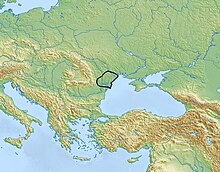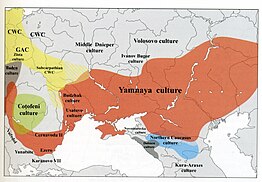The Usatove culture (Usatove in Ukrainian, Usatovo in Russian) is an Eneolithic group of the northwest and west Pontic region (ca. 3650-2740 BCE),[1] with influences from the Cucuteni–Trypillia culture as well as the Eneolithic steppe cultures of the North Pontic. Usatove culture flourished west and northwest of the Black Sea in more than 50 sites.[2] The culture got its name from the village of Usatove in the Odesa Oblast of Ukraine.[3]
 | |
| Geographical range | Northwest Black Sea |
|---|---|
| Period | Copper Age |
| Dates | ca. 3650–2740 BCE |
| Preceded by | Mikhaylovka culture, Kemi-Oba culture, Cucuteni–Trypillia culture, Cernavodă culture |
| Followed by | Yamnaya culture, Ezero culture, Coţofeni culture, Baden culture, possibly Troad, Aegean civilisation (?) |

The Usatove culture appears to be a mixture of the Eneolithic agrarian cultures of Southeast Europe, with influences from the steppe cultures from the Pontic steppe. The Eneolithic farming culture influences on Usatove include clay figurines and painted ceramics, while it shares tumulus (kurgan) burials and shell-tempered coarse wares with steppe cultures. It also displays items made of metal, such as arsenical bronze and silver, which suggests contacts with the North Caucasus as well as Anatolia.
In Ukraine, Usatove culture sites are predominantly located in the Dniester-Danube interfluve. The two largest Usatove archaeological sites in Ukraine, Usatove-Velykyj Kuyalnik and Mayaky,[4] contain kurgan and ground cemeteries (necropoli).
Within the Kurgan hypothesis, the Usatove culture represents the domination of native Cucuteni–Trypillia agriculturalists by Indo-European peoples from the steppe. According to Anthony, the roots of the pre-Germanic languages lay in the Usatove culture.[5]
While the generally accepted chronological placement of Usatove is in the second half of the 4th millennium BCE, radiocarbon dates on human remains identified as Usatove are consistently older. Most of these dates cluster around the last quarter of the 5th - first quarter of the 4th millennium BCE.[6][7] It is likely that the dates on human remains are influenced by aquatic reservoir effect, the precise quantification of which is not possible at the moment due the lack of radiocarbon and stable isotope data from contextual faunal remains.
Chronology
editRadiocarbon dates on pottery are between 3400 and 2900 BCE, around 600 years later than analyses in human bones, which indicate Usatove culture would have lasted (c. 4000-3500 BCE).[8]
Gallery
edit-
Metal, bone and ceramic artefacts
-
Arsenical bronze swords and copper axe, Ukraine[9]
-
Ceramic and metal artefacts
-
Ceramic vessels, metal tools and burial
-
Metal, bone and ceramic artefacts
-
Ceramic figurines and metal dagger
-
Burial mounds with stone constructions
-
Nevsha stele, c. 3000 BC
-
Stele, 3500-3000 BC
Genetics
editHaplogroups
editAccording to genetic studies, the Usatovo culture had male haplogroups such as E1b, J1, R1a. Of the female haplogroups, the following were present: U4b1b2, U5a1a1, T2h2, W1, X2d, U4d3.[10]
Autosomal DNA
editOne representative of the Usatovo culture was of mostly Neolithic origin, genetic studies suggest that the Usatovo culture arose as a result of the merger of the incoming representatives of the CVL (PBgroup) wedge with local representatives of the Trypillian culture, while another representative was almost genetically indistinguishable from the Yamnaya culture.[10]
See also
editReferences
edit- ^ Nikitin et al. 2022, p. 3: "Established dating, based on material culture, such as the presence of imports of ceramics from securely dated chronological periods, as well as radiometric radiocarbon dates on charcoal, pottery, and animal bone, primarily from the ditches of the Mayaky sanctuary (Table S1a), place the Usatove culture in the chronological period corresponding to ca. 3650-2740 BCE".
- ^ Nikitin 2022, p. 148: "[C]oinciding with the Trypillia stage CII of chronological periodization of the Pre-Cucuteni–Cucuteni–Trypillia Culture Complex (PCCTCC)...[t]here are over 50 sites known of Usatove in the west and northwest Pontic Region".
- ^ "Entry Display Web Page".
- ^ Nikitin 2022, p. 148: "The two major Usatove culture sites in Ukraine, Usatove–Velykyj Kuyalnik and Mayaky, produce a picture of Usatove as an amalgam of steppe and agrarian influences".
- ^ Anthony 2007, p. 359-360.
- ^ Mattila et al. 2023.
- ^ Nikitin et al. 2022, p. 12: "Taken together, the late 5th millennium Eneolithic dates obtained on human remains, whether or not affected by a RE [reservoir effect], as well as the finds of Trypillian A-BI period ceramics at Mayaky (Petrenko, 2009), corroborate the existence of proto-Usatove burials at the Mayaky complex, not readily distinguished in the field from the late Eneolithic Usatove burials".
- ^ Nikitin, Alexei, (2023). "Interpreting genetic ancestry of the builders of first kurgans", min. 21:50 to 24:30, ARWA Association, 14 May 2023.
- ^ Hansen, Svend (2017). "Arsenic Bronze. An archaeological introduction into a key innovation". Eurasia Antiqua. 23.
- ^ a b Nikitin & Ivanova 2024.
Sources
edit- Anthony, David W. (2007). The Horse, the Wheel, and Language: How Bronze-Age Riders from the Eurasian Steppes Shaped the Modern World. Princeton University Press. ISBN 978-0-691-14818-2.
- Mallory, J. P.; Adams, Douglas Q. (1997). "Ustatovo culture". Encyclopedia of Indo-European Culture. Taylor & Francis. p. 614. ISBN 1884964982.
- Manzura, Igor'; Petrenko, Vladislav (2022). Cemetery II of Usatovsky (based on 1984 excavations). Tyragetia, s.n., vol. XVI [XXXI], nr. 1, 2022, pp. 83-101, (in Russian).
- Mattila, Tiina; et al. (August 9, 2023). "Genetic continuity, isolation, and gene flow in Stone Age Central and Eastern Europe". Commun Biol. doi:10.21203/rs.3.rs-1966812/v1.
- Nikitin, Alexey G.; et al. (October 3, 2022). "New Radiocarbon Dating and Stable Isotope Analysis of Human Remains from the Usatovo Culture Site of Mayaki in Ukraine". SSRN. Rochester, NY. doi:10.2139/ssrn.4236123.
- Nikitin, Alexey G. (December 30, 2022). "The Origins and Chronology of the Usatove Culture". Archaeologia Lituana. doi:10.15388/ArchLit.2022.23.9.
- Nikitin, Alexey; Ivanova, Svetlana (18 April 2024). "Long-distance exchanges along the Black Sea coast in the Eneolithic and the steppe genetic ancestry problem". bioRxiv. doi:10.1101/2024.04.17.589600.
- Patokova, E.F. (1979) Усатовское поселение и могильники. Киев: Наукова Думка.
- Petrenko, VG; Káiser, E. (2011). Комплексный памятник Маяки: новые изотопные даты и некоторые вопросы хронологии наличных культур. Материалы по археологии Северного Причерноморья 12, 31-61.